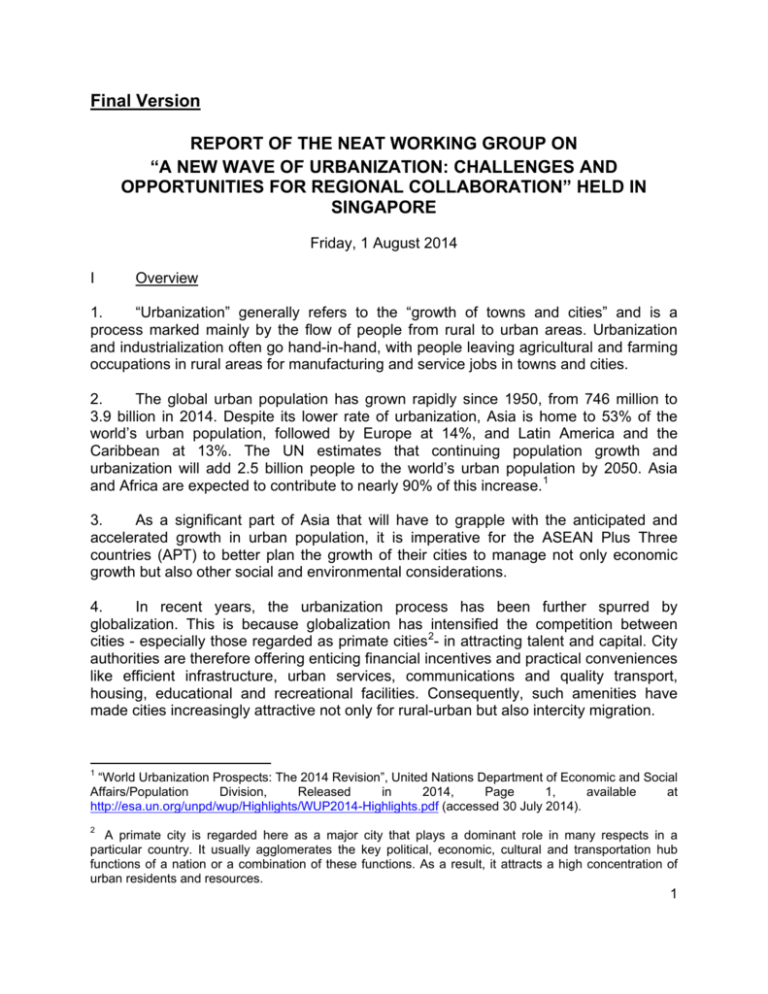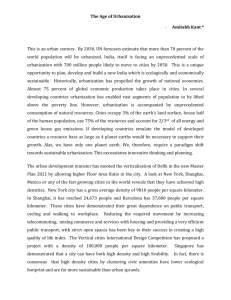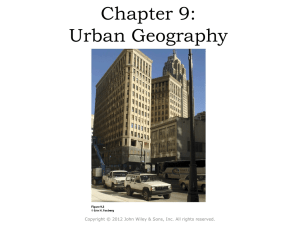A New Wave of Urbanization(sponsored by Singapore)
advertisement

Final Version REPORT OF THE NEAT WORKING GROUP ON “A NEW WAVE OF URBANIZATION: CHALLENGES AND OPPORTUNITIES FOR REGIONAL COLLABORATION” HELD IN SINGAPORE Friday, 1 August 2014 I Overview 1. “Urbanization” generally refers to the “growth of towns and cities” and is a process marked mainly by the flow of people from rural to urban areas. Urbanization and industrialization often go hand-in-hand, with people leaving agricultural and farming occupations in rural areas for manufacturing and service jobs in towns and cities. 2. The global urban population has grown rapidly since 1950, from 746 million to 3.9 billion in 2014. Despite its lower rate of urbanization, Asia is home to 53% of the world’s urban population, followed by Europe at 14%, and Latin America and the Caribbean at 13%. The UN estimates that continuing population growth and urbanization will add 2.5 billion people to the world’s urban population by 2050. Asia and Africa are expected to contribute to nearly 90% of this increase. 1 3. As a significant part of Asia that will have to grapple with the anticipated and accelerated growth in urban population, it is imperative for the ASEAN Plus Three countries (APT) to better plan the growth of their cities to manage not only economic growth but also other social and environmental considerations. 4. In recent years, the urbanization process has been further spurred by globalization. This is because globalization has intensified the competition between cities - especially those regarded as primate cities 2- in attracting talent and capital. City authorities are therefore offering enticing financial incentives and practical conveniences like efficient infrastructure, urban services, communications and quality transport, housing, educational and recreational facilities. Consequently, such amenities have made cities increasingly attractive not only for rural-urban but also intercity migration. 1 “World Urbanization Prospects: The 2014 Revision”, United Nations Department of Economic and Social Affairs/Population Division, Released in 2014, Page 1, available at http://esa.un.org/unpd/wup/Highlights/WUP2014-Highlights.pdf (accessed 30 July 2014). 2 A primate city is regarded here as a major city that plays a dominant role in many respects in a particular country. It usually agglomerates the key political, economic, cultural and transportation hub functions of a nation or a combination of these functions. As a result, it attracts a high concentration of urban residents and resources. 1 5. Concurrently, cities have had to deal with a host of problems arising from urbanization like over-crowding, traffic congestion, slums and open urban poverty, illegal settlers, pollution, water shortages, high energy consumption and large waste generation. Given the disparity in the APT countries, there is recognition that not all cities in these countries are as well equipped or ready to handle the expected increase in urban population. 6. This NEAT Working Group (WG) comprising experts from the APT countries had gathered in Singapore on 1 August 2014 to share their knowledge and experiences on how to better manage the growth of cities and/or the urbanization process. They further deliberated on a set of recommendations which can be found in the last section of this report. 7. The list of NEAT participants is at Annex. II Challenges Faced 8. The urbanization challenges faced by the APT countries are both wide-ranging and complex. On the economic front, there exists the perennial challenge of sustaining the economic dynamism of urban areas. Cities have to provide employment opportunities in line with their evolving economic structure and shifting comparative advantages vis-à-vis other cities. Going further, countries like Korea are focusing on urban regeneration strategies to revive the economy, social fabric and physical infrastructure of existing cities that have become relatively outdated due to changes in industrial structure and on the urban expansion of new cities and new city centers. With much attention focused on the urban areas, Malaysia stressed the need to ensure that the rural areas are not neglected in the process. Both rural development and urbanization should go hand-in-hand. 9. On the social front, some key challenges include tackling urban slums and poverty, social integration issues (especially urban migrants who are regarded as “second class citizens”), and social tensions and discontent among the urban population. Other social challenges include meeting the needs of the less socially mobile and aging population and related issues of providing barrier-free access and better social welfare coverage. 10. There are also challenges related to poor supervision, implementation and coordination; weak institutions or multiplicity of institutions (leading to fragmentation of roles and overlapping functions); lack of capacity (such as insufficiently trained skilled manpower); inadequate physical infrastructure; inadequate measures for disaster resilience; insufficient financial resources; food security and safety; and, poor planning or a generally top-down planning process that does not sufficiently take into account local realities or conditions. Countries like Laos even face the unique challenge of unexploded ordnance that continues to claim innocent lives and limit agriculture production and expansion. 2 11. Urbanization also produces negative externalities such as environmental pollution. It is important to incorporate green features and practices as well as implement mitigating and adaptation measures to reduce the carbon footprint arising from urbanization. In addition, a balance has to be struck between the rapid modernization accompanying urbanization on the one hand and the preservation of a country’s rich cultural and historical heritage on the other. The importance of striking such a balance was raised by Cambodia. Separately, Vietnam’s strong emphasis on getting the development of its cities right is evident in the statement by its Deputy Prime Minister Nguyen Sinh Hung who reportedly said: “Vietnam will have only one chance to get urbanization right. If we fail at urbanization, we will fail at industrialization and modernization”. 12. Many of the above challenges highlight the importance of dynamic urban governance as well as an integrated master planning and development. The former encompasses principles such as leading with vision and pragmatism, building a culture of integrity, cultivating sound institutions, involving the community as stakeholders, and working with markets (including the private sector) wherever possible. The latter essentially calls for a whole-of-government approach along with long-term design in the planning and development of a city especially coastal cities. Their implementation and concrete actions are imperative to overcome those challenges. Recommendations III 13. The governments of APT countries play an important role in managing the urbanization process to deliver improved standards of living to their people. The APT countries underscore the importance of having good urban governance and planning to bring about cities that are socially diverse, culturally vibrant and environmentally livable, an outcome which populations around the world increasingly aspire to. Below are the key recommendations to promote APT cooperation on urbanization: (a) Develop a strong urban economy in the APT countries to provide employment and a viable taxation/revenue base. Having a dynamic economy and sound public finance will make it possible for social and environmental programs to enhance the quality of life in a city. (b) Enhance the Plus Three Countries collaboration on the ASEAN Initiative on Environmentally Sustainable Cities (AIESC) to promote sharing of experiences, best practices and implementation of initiatives/programs. Enhance the Plus Three Countries collaboration on the support and implementation of the AIESC’s Key Indicators for Clean Air, Clean Land and Clean Water. (c) Create an APT Urban Forum to share knowledge and experience on urbanization challenges, policies and best practices. 3 (d) Work closely with international organizations such as ADB, UN-ESCAP and UN-Habitat to initiate and implement national and local urbanization initiatives/programs. In addition, APT countries could refer to the UN-Habitat’s Urban Indicator Program and Best Practices Program to improve their own urbanization process. (e) Empower and train local government officials to play a bigger role in urbanization processes/programs. (f) Adopt an open and inclusive approach to engage and involve relevant stakeholders to facilitate the urbanization process. (g) Publicize best practices and successful examples of urbanization in the APT countries. (h) Seek funding from financial institutions such as the ADB and other sources to meet the infrastructure needs of the APT countries. (i) Promote social programs and policies to deal with slums and open urban poverty. ..... 4 Annex Participants to the NEAT WG on Urbanization Organization Name 1. ASEAN Secretariat Dr. Raman Letchumanan Head, Environment Division, ASEAN Secretariat 2. Brunei (absent with apologies) 3. Cambodia H.E. Dr. Meng Bunnarith Deputy Secretary General of the National Committee on Land Management and Urban Planning, Deputy Director General of General Department on Land Management and Urban Planning, Ministry of Land Management, Urban Planning and Construction H.E. Mr. Pou Sothirak Executive Director of the Cambodian Institute for Cooperation and Peace and Advisor to the Royal Government of Cambodia 4. China Assoc. Prof Cui Haining Institute of Asian Studies, China Foreign Affairs University Dr. Komara Djaja Head, Graduate Program in Urban Studies, University of Indonesia 5. Indonesia 6. Japan Amb. Ishikawa Kaoru Senior Research Fellow, Senior Executive Director, Director of Research, The Japan Forum on International Relations 7. Korea Miss Kim Joo-young Ph.D. Candidate, Department of Archaeology and Cultural Anthropology, Chonbuk National University 5 8. Laos PDR Mr. Thavaone Singharaj Director of Research Division, Institute of Foreign Affairs 9. Malaysia Mrs. Mazlena Mazlan Researcher (Economics), Institute of Strategic and International Studies 10. Myanmar (absent with apologies) 11. Philippines Dr. Adoracion M. Navarro Senior Fellow, the Philippine Institute for Development Studies 12. Singapore Prof. Zheng Yongnian Professor and Director, East Asian Institute (EAI) Prof. John Wong Professorial Fellow, EAI Mr. Lye Liang Fook Research Fellow and Assistant Director, EAI Dr. Zhao Litao Senior Research Fellow, EAI 13. Thailand 14. Vietnam Mr. Loh Yi Chin Intern, EAI Assoc. Prof. Sureeporn Punpuing Director, Institute for Population and Social Research, Mahidol University Dr. Pham Thuy Loan Deputy Director, Vietnam National Institute of Architecture, Ministry of Construction 6







